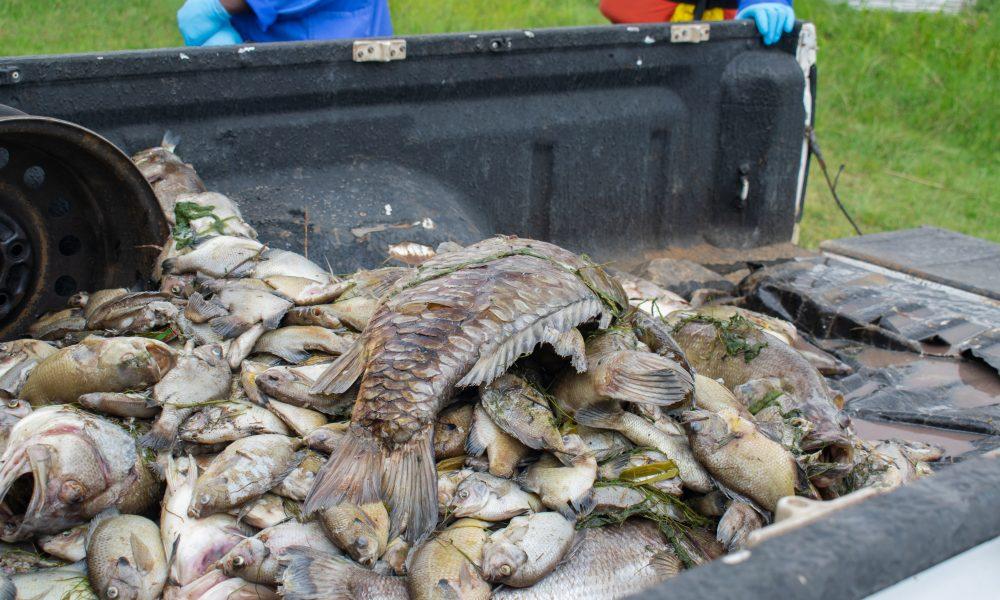Africa-Press – Lesotho. THE Principal Veterinary officer in the Ministry of Agriculture and Food Security has warned the community not to eat fish from Maqalika Dam after thousands of fish died due to suspected contamination.
Dozens of fish were found dead in Maqalika Dam, with carcasses floating and others just outside the water last Friday. Dr Mahloane says the cause of the deaths is yet to be established, making the water potentially dangerous for residents.
Dr Mahloane said samples of water have been taken to a laboratory for tests. Farmers have also been told to keep their animals away from the dam until a determination on the safety of the water is made.
Following the deaths of the fish, different ministries and departments gathered at the dam to come up with solutions to save the dying fish. Nthati Toae, a hydrologist from the Ministry of Natural Resources, said they believe “there is something wrong with the water” in the dam.
Primary findings show that it is only yellow fish that died in the dam. However, she could not tell what other varieties are found in Maqalika Dam. “Big and medium fish have died.
No small fish has died,” Toae said, adding that the water is also polluted and green in colour. She said there is an avalanche of plants in the dam, especially algae – a situation that diminishes oxygen levels.
Toae also said there is a lot of waste that is thrown into the dam from car wash businesses near the dam. “The more nutrients in the dam, the more the plants.
Sewage should not be dumped into this dam. Fish need clean water to live,” Toae said. She said people should stop depositing debris such as heavy metals and substances with mercury into the water.
Toae said they would be through with tests by the end of this week. “We have the capacity to conduct the tests,” she said. However, the danger doesn’t seem to deter locals from fishing.
A group of six young boys were spotted fishing in the same dam this week. The young fishermen were from Qoaling and Mamenoaneng, about five kilometres from the dam.
Fishing is their source of livelihood. “We are not aware that fishing is suspended here. We have not heard that some fish have died here,” one of them said.
This means some people out there are likely to eat fish unaware that it is contaminated. The school-age going boys said they sell the fish to people in Maseru and in the outskirts of the city.
Dr Josepha Morenammele, an executive officer from Durham Link, a company that oversees activities at the dam, expressed concern about the development.
Durham Link offers canoeing, kayaking and stand up paddle board services to tourists who frequent the Maqalika Dam almost every weekend. “We are worried because tourism is going to be negatively affected,” Dr Morenammele said.
He says students, security agents and people from the private sector use the dam for entertainment purposes. He said the company usually informs the Water and Sewerage Company (WASCO) if there are a lot of plants and algae in the dam.
Dr Morenammele said “a lot of waste” is dumped into the dam, making it unhealthy for the aqueous life. Meanwhile, Durham Link has announced the halting of activities at the dam until further notice.
Maseru City Council (MCC) spokesperson Lintle Mosala said the local authority is aware of the situation at Maqalika Dam. She said the dam belongs to WASCO.
“All the questions have to be channeled to WASCO,” Mosala said. WASCO public relations manager Lineo Moqasa says they are aware of the rubbish dumped into the Maqalika Dam.
She says they no longer use Maqalika for treatment of water for home use. Now they use Metolong Dam to supply Maseru, Teya-Teyaneng, Roma and Morija with water.
She said this has been happening since 2014. Moqasa says they worked hard with the MCC to protect Maqalika Dam. She says the dam was previously fenced to keep it safe but people vandalised the fence leaving the dam unsecured.
“We even have boards showing that no rubbish should be dumped into the dam,” she says.
She says people keep on encroaching regardless of the efforts they take to warn them against polluting the dam. She says they introduced the Maseru Waste Water Project to fight pollution of the dam.
That project, she says, was supposed to deal with a run-off from the Ha-Tšosane dumpsite and other tributaries channeling water into the dam. “It should be noted that we used Maqalika only during dry spells,” Moqasa says. She says they drew water from Mohokare River to supply homes. She says they have dam safety plans for all dams in the country.
For More News And Analysis About Lesotho Follow Africa-Press






